Philodendron Splendid is a stunning plant that features large, heart-shaped leaves that are velvety to the touch and it can reach a height of 10 feet. The leaves are dark green with prominent white veins that run from the midrib to the edges.
The Philodendron Splendid is a climbing plant and will need a moss pole or trellis for it to climb. This plant is considered rare and caring for this plant can be a bit challenging, but it is also considered to be a good plant for your first rare plant. Its magnificent foliage and the sheer size of its leaves make it a highly sought-after addition to any indoor garden collection.
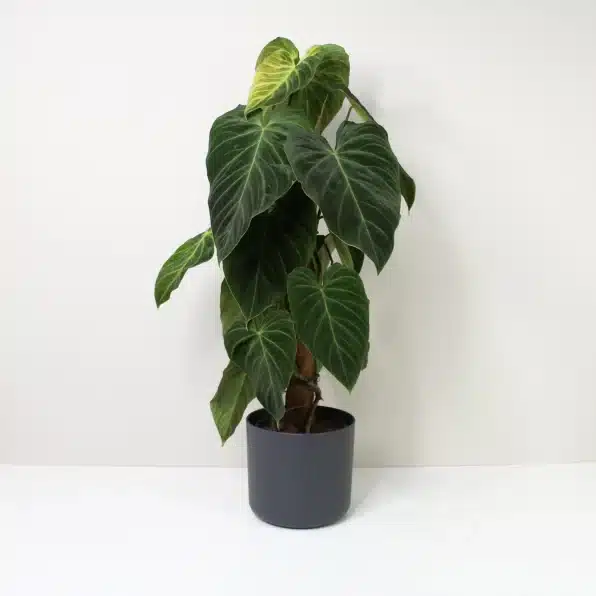
What Makes this Philodendron Splendid?
Philodendron Splendid is a tropical epiphytic plant that belongs to the Araceae family. It is a hybrid between the Philodendron melanochrysum and Philodendron verrucosum and features large, velvety heart-shaped leaves.
The Splendid is a beautiful plant that is native to the rainforests of Ecuador and prefers bright, indirect light and well-draining soil, kept consistently moist but not waterlogged. Philodendron Splendid is a popular choice for indoor plant collectors because of its beauty and rarity.
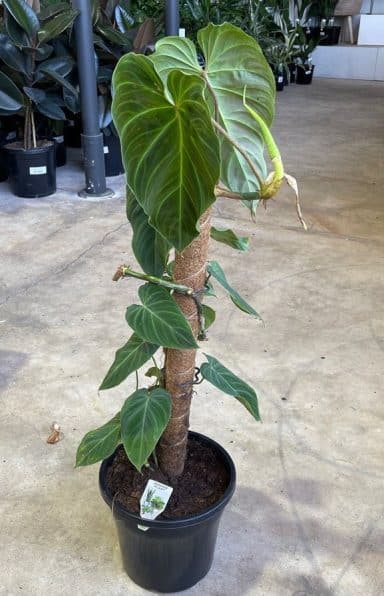
It’s a relatively new addition to the plant world, having been developed in Australia in the 1980s and only named in 2018. Philodendron Splendid is only available from a few select growers, and it can be quite expensive. However, it is a popular choice for plant collectors.
With proper care, your Splendid will thrive and provide you with years of enjoyment. In the following guide, we'll discuss some of the best practices for taking care of this beautiful Philodendron plant.
Splendid Philodendron Basics
Care Requirements for the Splendid Philodendron
Philodendron Splendid is relatively easy to care for but it does have a few specific needs. Below you will find the plant care guide to keep your plant looking healthy and vibrant and protected.
Type of Soil
It’s important to provide your Philodendron Splendid with the right soil to prevent overwatering and root rot. A well-draining soil will allow the excess moisture to drain away from the roots, preventing them from becoming soggy and rotting.
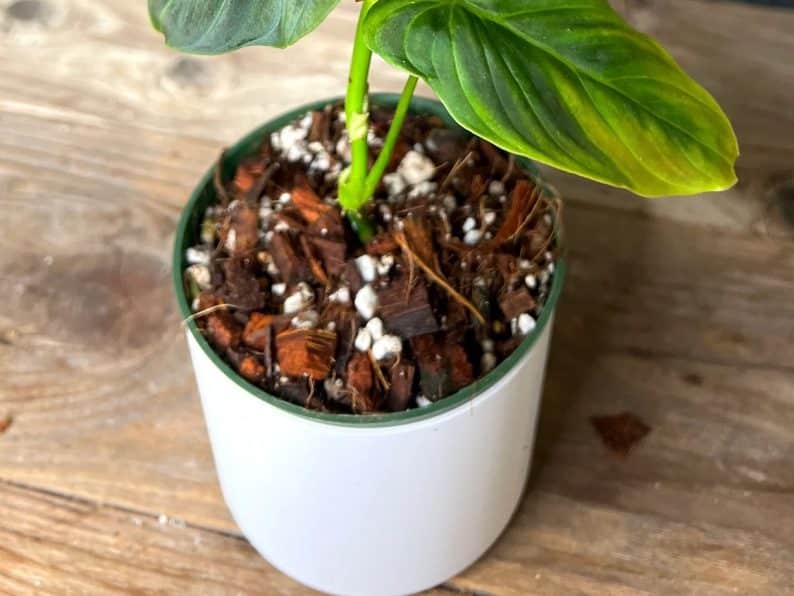
Sphagnum peat moss is a good option for Philodendron Splendid, as it is a lightweight and airy soil that will allow the roots to breathe. Soilless mixes like peat and vermiculite or peat and perlite are also good options, as they will provide good drainage and aeration for the roots.
You can also use a regular potting mix and amend it with perlite, vermiculite, and peat.
Watering Needs
The Splendid loves a moist environment and keeping the soil wet but not waterlogged is the perfect way to meet the watering needs of this tropical plant. As a house plant it prefers to be watered at its roots, avoiding watering from above will keep you having to worry about leaf issues.
You can allow the plant soil surface to dry about 2 inches down before watering again. You can use your finger to check this depth.
Lighting Needs
Born under the canopy of the Ecuadorian rainforest, the Philodendron Splendid is used to bright indirect light. Dappled lighting from a curtain or shade can mimic its natural setting. The beauty of this plant is that it can be set back and away from a window and still happily grow.

Philodendron Splendid Humidity & Temp Requirements
Philodendron Splendid is a tropical plant that prefers high humidity levels. The ideal humidity level for this plant is between 50% and 80%. If the humidity level is too low, the leaves of your plant may start to curl or turn brown. You can increase the humidity around your plant by placing it in a humid room or by misting the leaves regularly.
Philodendron Splendid prefers warm temperatures. The ideal temperature range for this plant is between 65°F and 85°F. If the temperature is too low, your plant may not grow as well or may even die. If the temperature is too high, your plant may start to wilt or drop its leaves.
If you are living in zones 10-11 you can grow the Splendid outdoors, or you can move it indoors if growing in cooler climates when the temperatures drop or there is a chance for frost.
Fertilizing the Plant
Big foliage takes a regular supply of food to grow and Philodendron Splendid is a heavy feeder. Regular fertilizing brings the best results. High nitrogen fertilizers or mixes especially made for foliage can be added once a month.
Always be careful not to over-fertilize your plant because this can cause root burn and ultimately the death of your plant. In the fall and winter, you can cut back on the fertilizer.
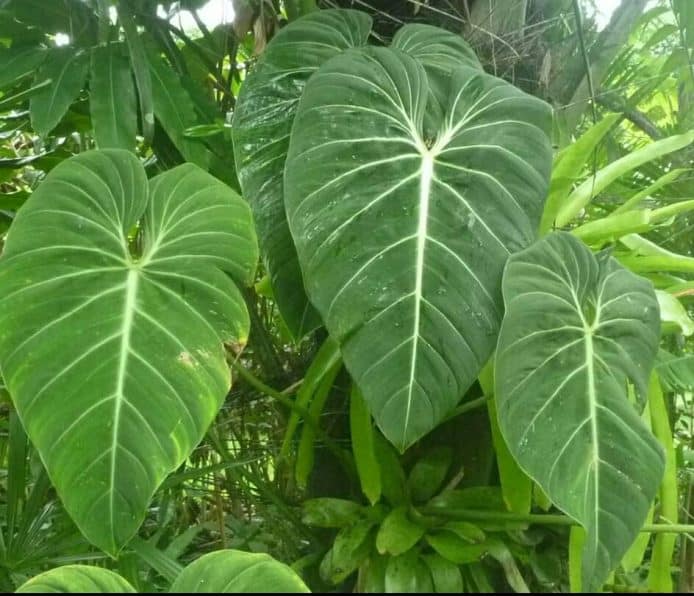
Pruning Method
Due to its low maintenance qualities, regular pruning won’t be necessary for this plant but the occasional trimming away of dead leaves, discolored or diseased leaves is a good idea.
If you’re trimming away any kind of diseased leaf make sure to dispose of it properly and away from your compost.
Here are some tips for pruning your Philodendron Splendid:
- Use sharp, clean pruning shears.
- Make your cuts just above a node, which is a point where a leaf or stem emerges from the main stem.
- Avoid cutting into the main stem, as this can damage the plant.
Philodendron Splendid Propagation Method
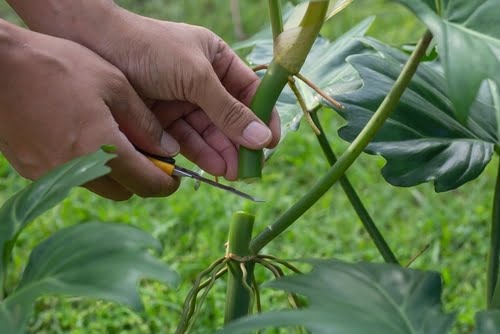
Here are the steps on how to propagate Philodendron Splendid by the stem cuttings method:
- Choose a healthy stem cutting with at least two nodes. A node is a point where a leaf or stem emerges from the main stem.
- Use a sharp, clean knife or shears to cut the stem cutting just below a node.
- Remove any leaves from the bottom half of the cutting.
- Dip the cut end of the cutting in rooting hormone, if desired.
- Plant the cutting in a pot of moist potting mix.
- Water the cutting well and place it in a warm, bright spot.
- Keep the soil moist but not soggy.
- The cutting should root in 4-6 weeks.
- Once the cutting has rooted, you can transplant it into a larger pot.
Similar Plants to the Philodendron Splendid
There are many plants that are similar to Philodendron Splendid in terms of appearance, care requirements, and family. Some of these plants include:
- Philodendron Verrucosum
- Philodendron Melanochrysum
- Philodendron Pink Princess
- Philodendron White Knight
- Philodendron Black Cardinal
- Philodendron Hastatum
- Philodendron Gloriosum
- Philodendron Pink Congo
- Philodendron Birkin
- Philodendron Prince of Orange
These plants are all members of the Araceae family, which is a large and diverse group of plants that includes many popular houseplants. They all have similar care requirements, which include bright, indirect light, moist but well-draining soil, and regular watering.
They are also all relatively easy to care for, making them popular choices for both experienced and beginner plant owners.
Here is a table that summarizes some of the key similarities and differences between Philodendron Splendid and some of its close relatives:
| Plant | Similarities | Differences |
|---|---|---|
| Philodendron Verrucosum | Similar leaf shape and size, velvety texture | Leaves are not as dark green, more of a silvery green color |
| Philodendron Melanochrysum | Similar leaf shape and size, dark green color | Leaves are not velvety, have a waxy sheen |
| Philodendron Pink Princess | Variegated leaves with pink and green coloration | Leaves are smaller and more delicate |
| Philodendron White Knight | Dark green leaves with a white variegation | Leaves are larger and more robust |
| Philodendron Black Cardinal | Dark green leaves with a red variegation | Leaves are smaller and more delicate |
| Philodendron Hastatum | Heart-shaped leaves with a silvery sheen | Leaves are smaller and more delicate |
| Philodendron Gloriosum | Large, dark green leaves with a silvery sheen | Leaves are waxier and have a more pronounced veining pattern |
| Philodendron Pink Congo | Variegated leaves with pink and green coloration | Leaves are larger and more robust |
| Philodendron Birkin | Variegated leaves with green, yellow, and white coloration | Leaves are smaller and more delicate |
| Philodendron Prince of Orange | Variegated leaves with orange and green coloration | Leaves are larger and more robust |
Ultimately, the best plant for you will depend on your individual preferences and needs. If you are looking for a plant with large, dark green leaves, Philodendron Splendid is a great option. If you are looking for a plant with variegated leaves, Philodendron Pink Princess or Philodendron White Knight are both good choices. And if you are looking for a plant that is easy to care for, Philodendron Verrucosum or Philodendron Melanochrysum are both good options.
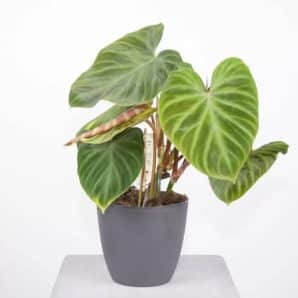
Philodendron Verrucosum | 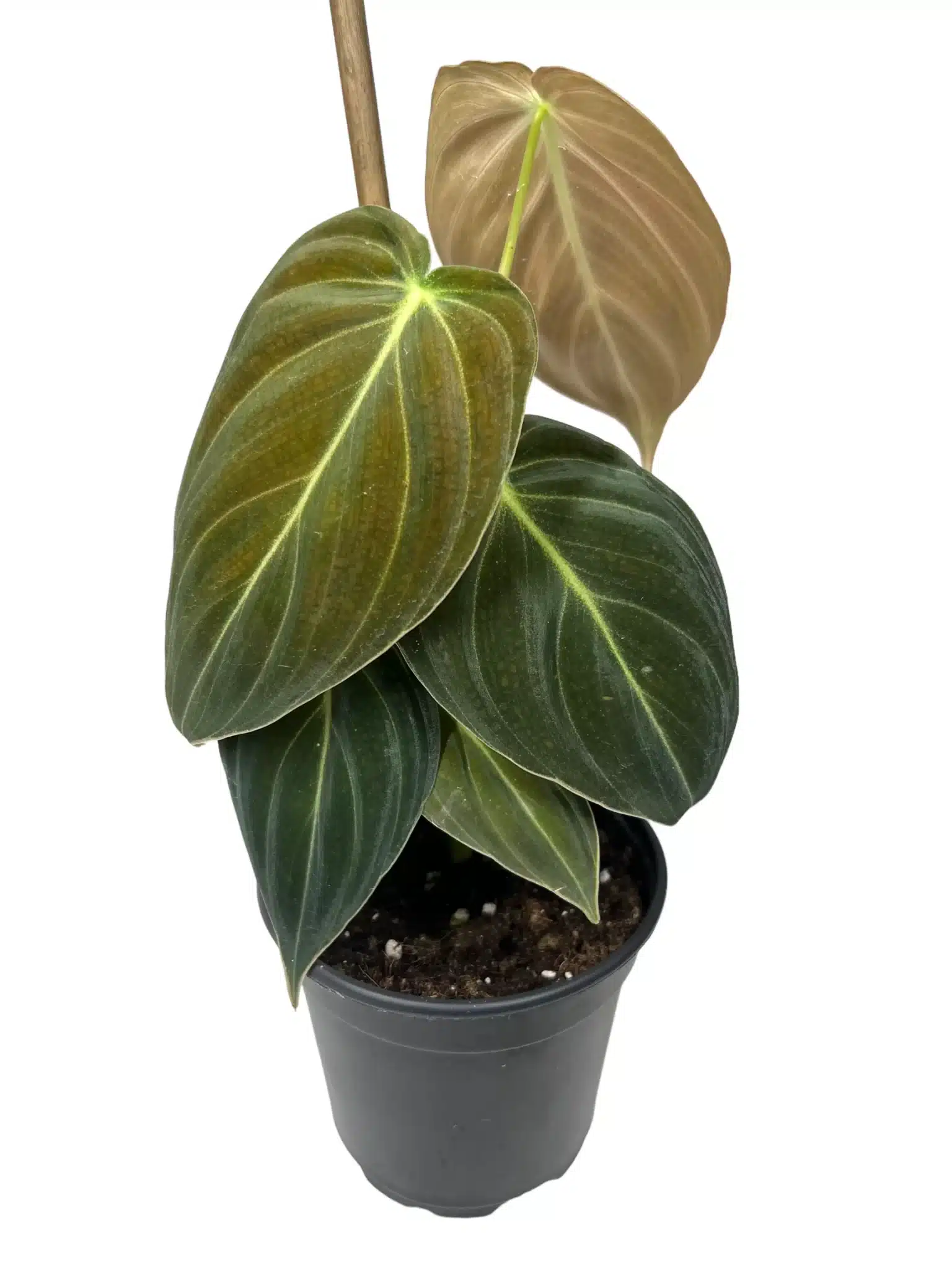 Philodendron Melanochrysum |
Common Problems with Philodendron Splendid
Philodendron Splendid is a beautiful and easy-to-care-for plant, but it is not immune to problems. Here are some of the most common problems that owners of this plant may encounter, along with some tips on how to prevent and treat them.
Growing
Here are some of the most common growing problems that Philodendron Splendid owners may see:
Overwatering: Philodendron Splendid is a tropical plant that prefers moist soil, but it is important not to overwater it. Overwatering can cause the roots to rot, which can kill the plant. To prevent overwatering, let the soil dry out slightly between waterings. You can check the moisture level of the soil by sticking your finger into it up to the first knuckle. If the soil is dry, it is time to water.
Underwatering: Just as overwatering can be harmful to Philodendron Splendid, so can underwatering. Underwatering can cause the leaves to wilt and turn yellow. To prevent underwatering, water your plant regularly, and make sure the soil is always moist, but not soggy.
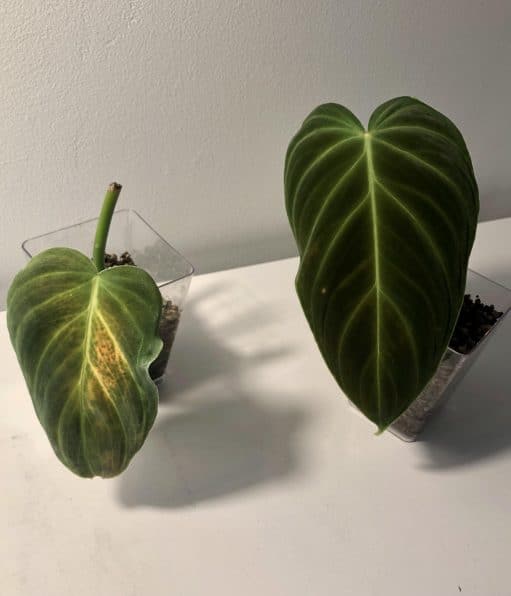
Not enough light: Philodendron Splendid prefers bright, indirect light. If it does not get enough light, the leaves will become pale and leggy. To provide your plant with enough light, place it in a spot where it will receive bright, indirect light for at least six hours per day.
Too much light: Too much direct sunlight can scorch the leaves of Philodendron Splendid. If your plant is getting too much light, the leaves will turn brown and crispy. To prevent this, move your plant to a spot where it will receive bright, indirect light.
Not enough humidity: Philodendron Splendid is a tropical plant that prefers high humidity. If the humidity in your home is low, the leaves of your plant may start to curl and turn brown. To increase the humidity around your plant, mist it with water regularly, or place it in a pebble tray filled with water.
Pests and diseases: Philodendron Splendid is susceptible to a variety of pests and diseases, including mealybugs, scale, and spider mites. If you see any pests or signs of disease on your plant, isolate it from your other plants and treat it with an appropriate pesticide or fungicide.
By following these tips, you can help your Philodendron Splendid thrive and grow into a beautiful and healthy plant.
Diseases
Here are some of the most common diseases that can affect Philodendron Splendid, along with some tips on how to prevent and treat them:
- Root Rot: Root rot is a fungal infection that can cause the roots of your plant to rot and die. This can be caused by overwatering, poor drainage, or a lack of oxygen in the soil. To prevent root rot, make sure your plant is not overwatered, and that the soil has good drainage. You can also try adding a layer of gravel or pebbles to the bottom of the pot to help improve drainage. If your plant does develop root rot, you will need to repot it in fresh, dry soil and remove any rotten roots.
- Leaf Spot: Leaf spot is a fungal infection that causes small, brown spots to appear on the leaves of your plant. This can be caused by overwatering, poor air circulation, or a lack of humidity. To prevent leaf spot, make sure your plant is not overwatered, and that the air around it is circulating well. You can also try increasing the humidity around your plant by misting it with water regularly. If your plant does develop leaf spots, you can treat it with a fungicide.

- Powdery Mildew: Powdery mildew is a fungal infection that causes a white, powdery substance to appear on the leaves of your plant. This can be caused by high humidity, poor air circulation, or a lack of sunlight. To prevent powdery mildew, make sure your plant is not in a humid environment, and that the air around it is circulating well. You can also try increasing the sunlight your plant receives. If your plant does develop powdery mildew, you can treat it with a fungicide.
- Viruses: There are a number of viruses that can affect Philodendron Splendid. These viruses can cause a variety of symptoms, including yellowing leaves, stunted growth, and leaf deformation. There is no cure for viral infections, so the best way to prevent them is to take steps to avoid introducing the virus to your plant. This includes buying your plants from reputable sources, and inspecting them carefully for signs of infection before bringing them home.
Pests
Here are some of the most common pests that can affect Philodendron Splendid.
- Mealybugs: Mealybugs are small, white insects that suck the sap out of plants. They can cause the leaves to turn yellow and drop, and they can also spread disease.
- Scale: Scale is a type of insect that attaches itself to the leaves and stems of plants. It can cause the leaves to turn yellow and drop, and it can also spread disease.
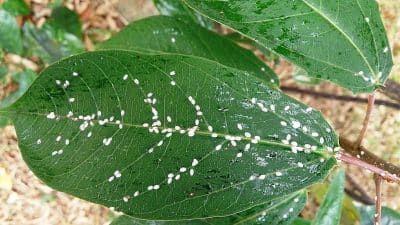
- Spider mites: Spider mites are small, spider-like insects that suck the sap out of plants. They can cause the leaves to turn yellow and drop, and they can also leave behind a web-like substance.
- Aphids: Aphids are small, soft-bodied insects that suck the sap out of plants. They can cause the leaves to turn yellow and drop, and they can also spread disease.
Other Things to Know About Philodendron Splendid
The name “Philodendron” comes from the Greek words “philo,” meaning “love,” and “dendron,” meaning “tree.” This is because most Philodendrons are naturally inclined to climb trees. This plant is a natural “tree hugger”.
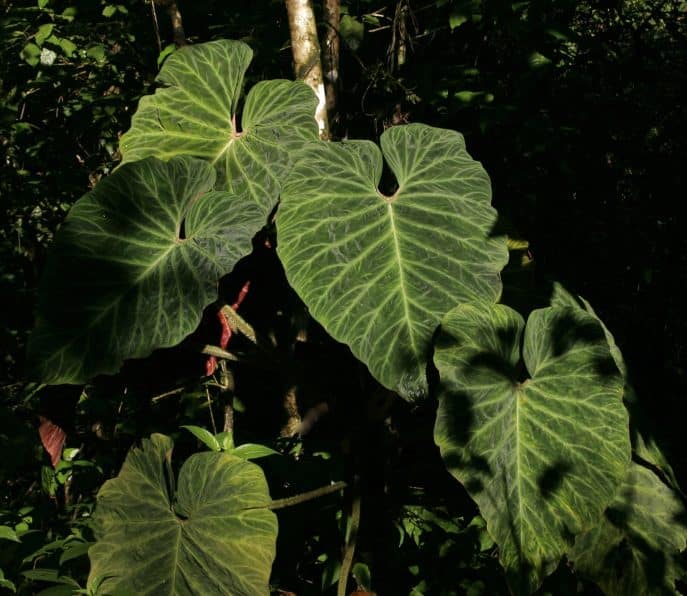
FAQ’s
What is the difference between a Philodendron Glorious and a Splendid Philodendron?
The main difference between the Glorious and the Splendid is in the veins of the leaf. The Splendid has more pronounced veining.
Where do I buy Philodendron Splendid?
The best place to look for the Philodendron Splendid would be in a specialty plant store.
How do I know if my Philodendron Splendid is mature?
There's no one size fits all answer, but you can tell if your Splendid is mature by size, leaf size, color, number of leaves, and the overall health of the plant.

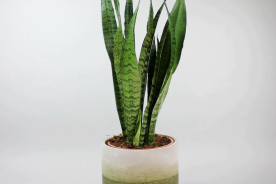



No Comments